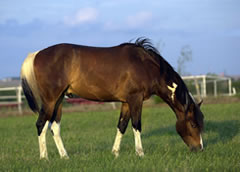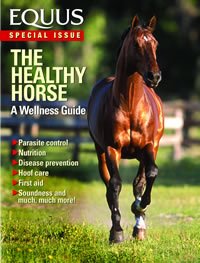
Highly Recommended Vaccinations
This at-a-glance vaccination chart shows you the vaccinations recommended for your horse, based on his lifestyle.
By the Editors of Practical Horseman magazine
For your purpose of choosing the best vaccination and deworming strategy for your horse, these are the three basic equine lifestyles:
Open herd: This is your horse's situation if he travels frequently to shows or other events where he comes in contact with unfamiliar horses whose worming and vaccination schedules you don't know. Even if he's stay-at-home, he's in an open herd if he boards in a large facility with a high turnover and even more so if manure is not removed regularly from the turnout areas.
Semi-open herd: If your horse and those around him are on regular vaccination and deworming schedules and their fecal egg counts are monitored and all newcomers to the barn are immediately vaccinated and dewormed, your horse fits here.
Closed herd: This lifestyle gives you horse the least exposure to worms and germs. He qualifies if he's in an extremely controlled environment with rare exposure to unfamiliar horses, is turned out in regularly cleaned paddocks and benefits from regular vaccination and deworming program that includes fecal egg counts.
Now that you know your horse's herd type, use the chart below to develop a custom plan that optimally immunizes your horse against disease and controls his exposure to parasites.
HIGHLY RECOMMENDED VACCINATIONS
(Don't Leave Home Without Them)
Disease Description Protocol/Comments
TETANUS TOXOID When a wound such as a deep puncture is contaminated, toxins from the anaerobic bacterium Clostridium tetani, which thrives in the equine environment, cause lockjaw and general muscle spasms, usually resulting in death. For all herd types: Vaccinate yearly.
Give a booster vaccination at the time of penetrating injury or surgery if most recent dose was more than six months earlier. Broodmares should receive a vaccination four to six weeks before foaling.
EE/WEE Eastern and Western Equine Encephalomyelitis, aka Sleeping Sickness, is a vector-borne viral disease causing inflammation of the brain and spinal cord. For all herd types: Vaccinate yearly, in spring (before insect season).
Where Encephalomyelitis is common and/or where there are two annual mosquito "blooms," give a booster EEE/WEE vaccination every six months about a month before the onset of the mosquito season. A vaccination for Venezuelan Equine Encephalomyelitis is also recommended for horses in U.S border areas of Arizona, California, New Mexico and Texas.
RABIES Invasion of the central nervous system by a virus that is fatal if untreated; it also transmits to other animals--including humans. For all herd types: Recommended yearly, especially in areas where rabid wildlife is reported or areas considered to be endemic.
WEST NILE VIRAL ENCEPHALMYELITIS A mosquito-born encephalitis that can be deadly to horses and has been reported in all but a few states. For all herd types: Vaccination recommended very six months.
Two West Nile Virus vaccines are now available; consult your veterinarian about the best choice for your horse. If you're vaccinating your horse against WNV for the first time, he'll require a booster after the initial injection.
INFLUENZA Acute, contagious, viral respiratory-tract inflammation; occurs in isolated cases or in epidemics. Your veterinarian can recommend which form of the vaccine is suitable for your horse. Intranasal Vaccine
Open herd: Every four months.
Semi-open herd: Every six months.
Closed herd: Every six months; add booster two to four weeks before anticipated exposure, such as a show or a long haul.
Intranasal vaccine gives a good immune response when properly applied but can be tricky to administer. If your horse is fussy about substances sprayed up his nostrils, consider using the injectable form.
Injectable Vaccine
Open herd: Every four months.
Semi-open herd: Every four months.
Closed herd: Every six months; add a booster two to four weeks before anticipated exposure.
RHINOPNEUMONITIS Caused by a herpes virus, a contagious infection of the respiratory tract; often induces abortion in pregnant mares. Open herd: Every other month.
Semi-open herd: Every four months.
Closed herd: (Optional) Every six months.
Rhinopneumonitis and Influenza vaccines are sometimes administered in a single combined dose. If your mare is bred, consult your veterinarian about a Rhino vaccination schedule to safeguard her pregnancy.
This chart originally appeared in the article "Protect Your Horse from Worms and Germs" in the April 2005 issue of Practical Horseman magazine.



